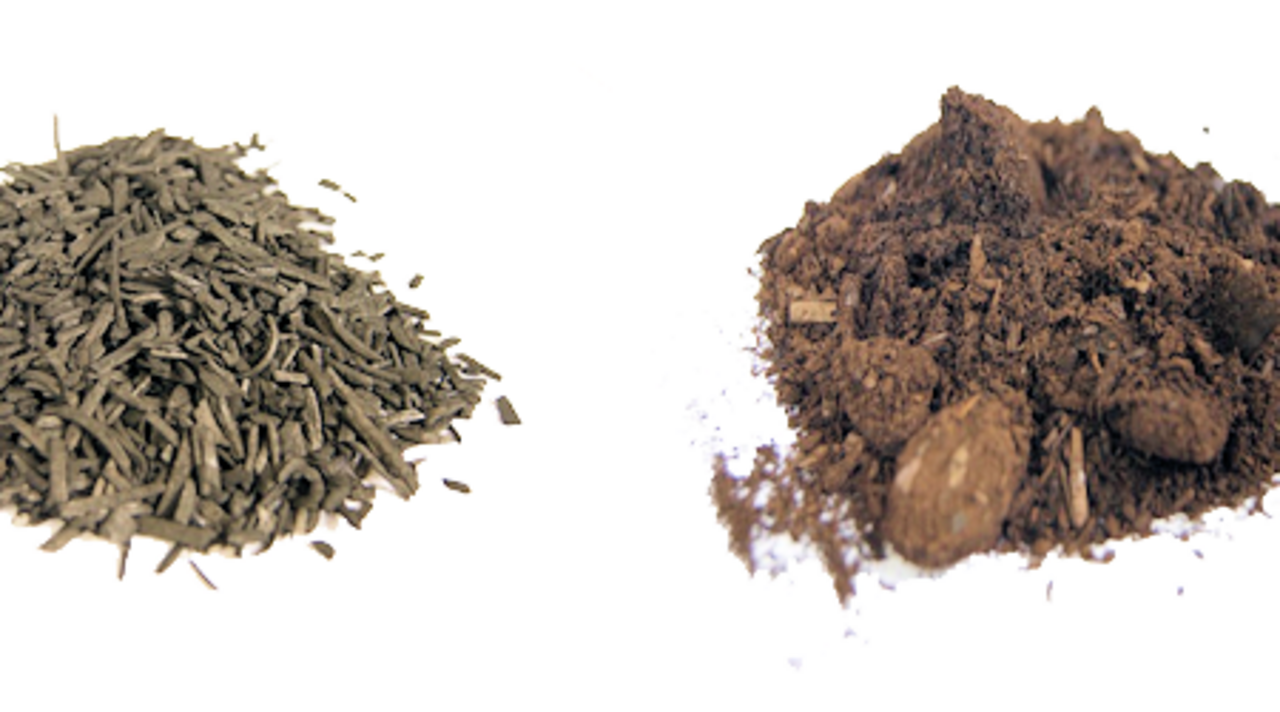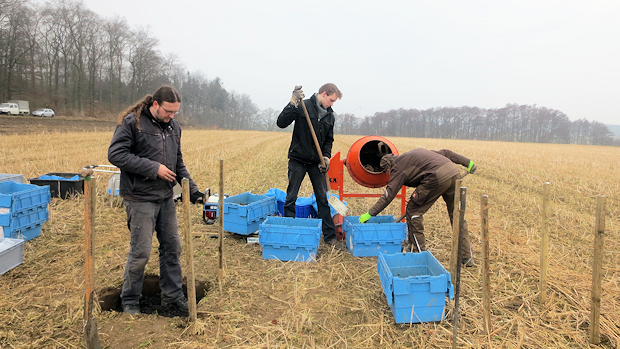Project
Biochar in agriculture

Use of chars from pyrolysis and hydrothermal carbonization in agriculture
Application of biochar in agricultural soils and assessment of their potential to reduce leaching of nutrients and pesticides as well as greenhouse gas emissions from soils is investigated in a broad-based project at the Thünen-Institute of Climate-smart Agriculture since 2010.
Background and Objective
The use of heavy machinery and mineral fertilizer with the intensification of agriculture led to significantly increased crop yields. However, wrong fertilizer management, especially if not adapted to the plants needs, leads to negative side effects: on the one hand, the nitrogen (N) surplus may lead to increasing emissions of nitrous oxide (N2O), while on the other hand nitrate (NO3) leaching to groundwater and surface water may occur.
In order to counteract negative side effects of industrialization and intensivation of agriculture, new methods gain increasing interest. One of these methods is the use of biochar (products from the carbonization of biomass) in agricultural soils. It is assumed that carbonization leads to long-term sequestration of carbon dioxide from the atmosphere which in turn offers the possibility to actively counteract climate change. Additionally, application of the char to soil may reduce N2O emissions, enhance the soil water capacity and decrease leaching of nitrate and other nutrients (calcium, potassium, magnesium, phosphorous) as well as pesticides from agricultural soils because of different physico-chemical properties of the soil-char-composite compared to the bare soil.
Biochars can be produced using different carbonization processes, the two most commonly used of which are in the focus of the present project. Pyrolysis is thermal transformation of biomass at high temperatures (>450°C) and under the absence of oxygen (pyrochars) while hydrothermal carbonisation (HTC) is a carbonisation process of wet biomass at 180-250°C under high pressure (HTC- or hydrochars). These two techniques yield chars with different physico-chemical properties which are investigated concerning their potential as a soil amendment and to reduce greenhouse gases and to sequester carbon after application in agricultural soils is assessed in the framework of this project.
This research projects aims to investigate the follwing questions:
- Are pyrochars and hydrochars capable of reducing leaching of nutrients and pesticides from agricultural soils?
- How does application of pyrochars and hydrochars to soil influence the water-holding capacity of the soil?
- How does the sorptive capacity of the chars change over time in the field (aging)?
- Are pyrochars and hydrochars a means for carbon sequestration in agricultural soils?
- Can application of pyrochar or hydrochar help to reduce fertilizer-derived NH3 emissions?
This research projects aims to investigate the follwing questions:
- Are pyrochars and hydrochars capable of reducing leaching of nutrients and pesticides from agricultural soils?
- How does application of pyrochars and hydrochars to soil influence the water-holding capacity of the soil?
- How does the sorptive capacity of the chars change over time in the field (aging)?
- Are pyrochars and hydrochars a means for carbon sequestration in agricultural soils?
- Can application of pyrochar or hydrochar to soils help to reduce manure-derived NH3 emissions?
Approach
We investigate phyrochars and hydrochars derived from different feedstock (e.g. Miscanthus, wood chips, digestates) in different soil types (sandy and loamy soils) using lab and field studies.
Data and Methods
The chars that were used for laboratory experiments were derived from hydrothermal carbonization (HTC) and pyrolysis and were produced from three feedstock materials with different physicochemical properties (woodchips (95% poplar, 5% willow), Miscanthus x giganteus, and digestates (99% maize)). The hydrochars were carbonized with water (1:10, w/w) in a batch reactor for 6 h with a pressure of 2 MPa at 200°C and at 250°C (SmartCarbon AG, Jettingen, Germany) in order to investigate the effect of process temperature on biochar. Pyrochars were produced in a Pyreg reactor (PYREG GmbH, Dörth) for 0.75 h at 750°C.
For the field experiment, only pyrochar and hydrochar (200°C) from Miscanthus were used.
Results
The results from this project revealed that feedstock and process conditions essentially determine the effectiveness of potential functionalities of biochars in soils.
The stability of the biochars increased with increasing degree of carbonization (i.e. hydrochar procuced at 200°C < hydrochar produced at 250°C < pyrochar) and was to some extent dependent on the feedstock material (especially for more gently carbonized chars stability increased with lignin content or C/N ratio of the feedstock material). Our findings from lab incubation experiments were supported by our in situ field incubation: while C derived from pyrochar did not change over time, hydrochar-C decreased 75±20% after 19 months in the field. There was no difference in the decomposition dynamics of the chars among the three field sites with different soil types.
The specific surface area (SSA) has often been addressed to be a crucial factor for increasing water retention in soil after biochar amendment. In contrast, we found out that hydrochars (which possess a significantly lower SSA compared to pyrochars) are also capable to effectively increase the retention of plant available water of the soil.
Pyrochars as well as hydrochars were capable of reducing leaching of the relatively water soluble herbicide Isoproturon (IPU): Sorption of IPU increased by a factor of 13 after hydrochar application and by a factor of 2283 after pyrochar application. The mineralization of the pesticide was negatively correlated with the sorption capacity of the chars and positively with char degradability, i.e. degree of carbonization. Presumably, pyrochars will occlude the pesticide in their micro-porous structure resulting in long-term persistence of IPU in soil. In contrast, hydrochars will guarantee the bioaccessibility of IPU, because they have a higher content of water extractable C and oxygen containing functional groups, to which the pesticide is bound reversibly. Further, hydrochars are considerably more easily degradable.
The nutrient retention potential of chars (i.e., nitrate, ammonium, and phosphate) differed strongly with nutrient, char type (hydrochar vs. pyrochar), and type of carbonized feedstock, as well as amended soil type. Among nine different types of chars tested in a laboratory batch experiment, only pyrochars showed the ability to effectively retain nitrate, ammonium, and phosphate. Moreover, the nutrient retention effect seems to be of very limited duration: After 7 months in the field, 60-80% of the adsorption capacity of pyrochar was lost. Underlying mechanisms are poorly understood, but our results cast doubt on the efficiency of char application to minimize the problems of nutrient leaching from agricultural soils to the groundwater and adjacent ecosystems.
Application of pyrochar and hydrochar had an effect on NH3 emissions from organic manure (cattle slurry and poultry litter) – however, this was mainly driven by char-induced pH changes. A reduction of NH3 emissions due to adsorption of NH4+ was not observed. Furthermore, the efficiency of char additions to reduce nitrogen losses as ammonia from manures was minor in comparison to manure acidification.
In conclusion, we found that both, pyrochars and hydrochars can improve certain properties when applied to soil. However, neither hydrochar nor pyrochar showed a multi-beneficial usage. In fact, the application of one char type causes several, probably undesired effects. Exemplarily, on the one hand, hydrochars can reduce the mobility of contaminants in soil through sorption and coevally guarantee their bioaccessibility due to hydrochar degradation. On the other hand, the degradation of hydrochars makes hydrochar inappropriate for C sequestration. On the other hand, highly stable biochars such as pyrochars may be selected for C sequestration in extensively used agricultural soils, but its application in conventional, intensively used agricultural soils may provoke unforeseeable, negative effects (e.g., pesticide accumulation).
Thünen-Contact

Involved Thünen-Partners
Funding Body
-
Deutsche Forschungsgemeinschaft (DFG)
(national, öffentlich)
Duration
1.2010 - 12.2015
More Information
Project status:
finished
Publications
- 0
Gronwald M, Helfrich M, Don A, Fuß R, Well R, Flessa H (2018) Application of hydrochar and pyrochar to manure is not effective for mitigation of ammonia emissions from cattle slurry and poultry manure. Biol Fertil Soils 54:451-465, DOI:10.1007/s00374-018-1273-x)
- 1
Gronwald M, Vos C, Helfrich M, Don A (2016) Stability of pyrochar and hydrochar in agricultural soil - a new field incubation method. Geoderma 284:85-92, DOI:10.1016/j.geoderma.2016.08.019
- 2
Eibisch N, Durner W, Bechtold M, Fuß R, Mikutta R, Woche SK, Helfrich M (2015) Does water repellency of pyrochars and hydrochars counter their positive effects on soil hydraulic properties? Geoderma 245-246:31-39, DOI:10.1016/j.geoderma.2015.01.009
- 3
Eibisch N, Schroll R, Fuß R (2015) Effect of pyrochar and hydrochar amendments on the mineralization of the herbicide isoproturon in an agricultural soil. Chemosphere 134:528-535, DOI:10.1016/j.chemosphere.2014.11.074
- 4
Gronwald M, Don A, Tiemeyer B, Helfrich M (2015) Effects of fresh and aged chars from pyrolysis and hydrothermal carbonization on nutrient sorption in agricultural soils. Soil(1):475-489, DOI:10.5194/soil-1-475-2015
- 5
Eibisch N, Schroll R, Fuß R, Mikutta R, Helfrich M, Flessa H (2015) Pyrochars and hydrochars differently alter the sorption of the herbicide isoprotyron in an agricultural soil. Chemosphere 119:155-162, DOI:10.1016/j.chemospere.2014.05.059
- 6
Eibisch N, Helfrich M, Don A, Mikutta R, Kruse A, Ellerbrock RH, Flessa H (2013) Properties and degradability of hydrothermal carbonization products. J Environ Quality 42(5):1565-1573, doi:10.2134/jeq2013.02.0045

![[Translate to English:] [Translate to English:]](/media/_processed_/6/4/csm_titel_CO2Kampagne8_afeea2273e.png)
![[Translate to English:] [Translate to English:]](/media/_processed_/4/1/csm_titel_93px_CO2Kampagne8_9b0f3354d4.png)






